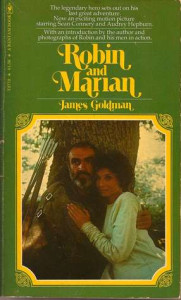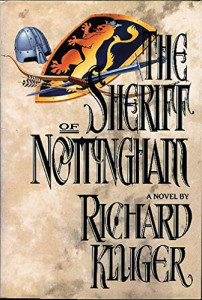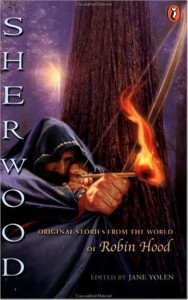Take no scorn to wear the horn
It was the crest when you were born
Your father’s father wore it
And your father wore it too
Robin Hood and Little John
Have both gone to the fair o
and we will to the merry green wood
To hunt the buck and hare o
“Hal-N-Tow” (traditional)
The fiction section of the Green Man library holds wonders beyond your wildest dreams. And among those wonders are many, many works about Robin Hood, a favourite character among our staff. The four works that I am looking at in this review all take novel approaches to this legendary outlaw. (And do amble down later tonight to the Green Man theater, as we’ll be showing the recently released DVD version of Robin and Marian!) Now, as I noted in my review of two books on him, J.C. Holt’s Robin Hood, and Stephen Knight’s Robin Hood: A Complete Study of the English Outlaw, ‘One of the most enduring romantic heroes of the Middle Ages is the outlaw Robin Hood of England, but the debate as to him being a living man or only a legend continues to this day. Old ballads relate that Robin Hood and his followers roamed the green depths of Sherwood Forest, near Nottingham, in the center of England. There they lived a uninhibited life, passing their time playing games of archery, hunting the king’s deer, and robbing the rich. They apparently shared their swag with the poor and never injured women or children. Sounds to good to be true, doesn’t it?’
These four books certainly suggest alternative ways of looking at the legend that help to strip away much of the romanticism that Howard Pyle gave it in his novel The Merry Adventures of Robin Hood.
James Goldman’s Robin and Marian is, in large part, merely the screenplay for the superb Robin and Marian film first released a quarter of a century ago, now out on DVD. Goldman also wrote The Lion in Winter, which was a hit as both a movie and a play, and Myself as Witness, a novel centering on King John – whom Goldman admits he treated badly in The Lion in Winter. The plot here centers around an aged Robin Hood, returned after years away at the Crusades with an increasingly mad King Richard. Robin and Little John return to find that the sheriff of Nottingham is up to his old nasty tricks, and that Maid Marian is now a nun! Robin and Marian doesn’t so much destroy the legend of Robin Hood and Maid Marian as answer the question of what comes after the glory years are long past. Suffice it to say that an aged Robin is not a pretty sight!
The major portion of this book is Goldman’s original screenplay, ‘adapted’ by Richard Lester for the movie, which starred Audrey Hepburn (Maid Marian), Sean Connery (Robin Hood), Robert Shaw (Sheriff of Nottingham), Nicol Williamson (Little John), and Richard Harris (King Richard). Also included in Robin and Marian are three entertaining essays, to wit: ‘Where Have All the Heroes Gone?’ which mourns the lack of present-day true heroes, ponders the fate of heroes grown old – Ulysses, Ben Hogan, Fritz Kreisler – sets up Goldman’s underlying premise as to what might have happened to Robin and Marian as they aged, and asks why some of the variants of the myth have Marian killing Robin; ‘What All the Singing Was About’ gives some historical background on the Robin Hood myth and why it has endured for nearly a thousand years and still fascinates us; and ‘Everything You Always Wanted to Know about Screenplays and Were Afraid to Ask’ is his insider’s view of writing the screenplay, selling it, and making the movie. A nifty package of goodies, but it begs the question as to whether it’s worth reading. Errrr, yes. Mostly. It’s not as good as the movie on which it’s based, but it makes, as does The Lion in Winter script, for a better look at the actual words that  Goldman wrote than do the movies. What it lacks is any feeling of being a story, as Sean Connery and the other cast members take a good script and make it live. In contrast, The Lion in Winter works equally well for me either as something to be read or as something to be watched.
Goldman wrote than do the movies. What it lacks is any feeling of being a story, as Sean Connery and the other cast members take a good script and make it live. In contrast, The Lion in Winter works equally well for me either as something to be read or as something to be watched.
Robin McKinley’s The Outlaws of Sherwood is yet another fine reading experience that Ace has just released in a very fine trade paper edition with stunning new artwork. First printed in hardcover by Greenwillow Books in 1984, this is still one of the better takes on the Robin Hood myth. Robin Longbow is a lowly, utterly poor forester in Sherwood Forest, not quite making a living, unable to afford the taxes on the holdings his late father left him, and quite unable to keep his temper in check when he is confronted by the taunts of the Chief Forester’s favorite. One shot goes astray, and he has in the eyes of the Sheriff of Nottingham murdered the man. From then on, Robin is on the run deep into the woods, but he is not alone. Joined first by his friends Much and Marian – whose father disapproves of her friendship with Robin – and then by more and more folks who despise the Norman lords who tax them far beyond their ability to pay, Robin builds a rag-tag group of Saxon outlaws deep in Sherwood, who risk the gallows for opposing the Sheriff and his Norman overlords.
In tone, it reminds me of the 1991 film that featured Patrick Bergin as Robin and Uma Thurman as Maid Marian. Both use the motif of ruthless Norman invaders oppressing the Saxons, who are the ‘true British.’ And both turn the concept of a joyful Robin on its head. As I hinted before, I consider the Howard Pyle version of the Robin Hood tale to be one of the worst done. Almost everything done since Pyle has been better than what he did.
One of most interesting characters in this book is one added to the canon by McKinley herself: Cecily of Norwell, Will Scarlet’s little sister, who does not appear in the Robin Hood mythos. Cecil, as she comes to be named by all who encounter ‘him,’ runs away from home to avoid the prospect of marriage to an aging and not-terribly-pleasant Norman lord. She disguises herself as a boy and proves herself an excellent archer to join Robin’s band of rogues. Every character here, good or not, is fleshed out rather well, and everyone acts true to the times. So you’ve got good characters, interesting plotting, and a superbly thought-out background. What more could you want? This is an original telling of what far too often becomes a boring retelling of the Robin Hood legend. Good stuff indeed!
Philip had always viewed the woodsman as an endearing lout who, for all his antic spirit, possessed a soul of honor; now he was exposed as capable of as much treachery as the craftiest of courtiers. ‘This is a spiteful rogue, gentlemen, who feeds on sour grapes.’ – Richard Kluger’s The Sheriff of Nottingham
 Richard Kluger’s The Sheriff of Nottingham is not centered on Robin, but rather considers the matter of the Sheriff who is so reviled in most tellings. And Kluger’s sympathies clearly lie with the Sheriff! This is a novel based on history, so it is much in the vein of the aforementioned The Lion in Winter, which built a fictional tale off of (admittedly) thin facts. This is not at all a novel about Robin Hood and what he did. What you have is a well-written what-might-have-been novel about a real man, Philip Mark. He started his career as a common soldier, but quickly rose in rank. His luck ended as far as history is concerned when he became the world’s most infamous public official – yes, Philip was the sheriff of Nottinghamshire and Derbyshire, possibly the one who encountered the man responsible for what became the legend of Robin Hood. Phillip was not a good Sheriff, as John Holt noted in his book on Robin Hood. ‘Philip’s conduct of his shrievalty included robbery, false arrest, unjust decisions, and persistent attacks on local landed interests, both secular and ecclesiastical.’ The Sheriff of Nottingham is a fictional look at the politics of the early thirteenth century and the people of those times who suffered under Philip Mark. It is well worth reading. It’s is not an easy or fast read, but if you stick with it, you will find much to hold your attention. I note that Sharon Kay Penman fans in particular will find much to like in this novel.
Richard Kluger’s The Sheriff of Nottingham is not centered on Robin, but rather considers the matter of the Sheriff who is so reviled in most tellings. And Kluger’s sympathies clearly lie with the Sheriff! This is a novel based on history, so it is much in the vein of the aforementioned The Lion in Winter, which built a fictional tale off of (admittedly) thin facts. This is not at all a novel about Robin Hood and what he did. What you have is a well-written what-might-have-been novel about a real man, Philip Mark. He started his career as a common soldier, but quickly rose in rank. His luck ended as far as history is concerned when he became the world’s most infamous public official – yes, Philip was the sheriff of Nottinghamshire and Derbyshire, possibly the one who encountered the man responsible for what became the legend of Robin Hood. Phillip was not a good Sheriff, as John Holt noted in his book on Robin Hood. ‘Philip’s conduct of his shrievalty included robbery, false arrest, unjust decisions, and persistent attacks on local landed interests, both secular and ecclesiastical.’ The Sheriff of Nottingham is a fictional look at the politics of the early thirteenth century and the people of those times who suffered under Philip Mark. It is well worth reading. It’s is not an easy or fast read, but if you stick with it, you will find much to hold your attention. I note that Sharon Kay Penman fans in particular will find much to like in this novel.
On a lighter note, Jane Yolen offers up a collection called Sherwood. I suggest you read it after The Sheriff of Nottingham, as it is indeed a trifle. And there’s nothing wrong with a trifle as long as it’s well-crafted! Green Man has a fondness for anything that Jane Yolen has done – and we’ve reviewed just a small slice of possibly three hundred plus works that have earned her the title of ‘America’s Hans Christian Anderson.’ Yolen is, in my opinion, incapable of picking a bad story, and the writers herein are equally incapable of writing a bad tale. Sherwood contains stories by Timons Esaias, Robert J. Harris, Anna Kirwan, Nancy Springer, Adam Stemple, and Maxine Trottier. All are quick, delightful reads suitable for reading of a warm summer’s evening. I particularly like Adam Stemple’s tale of a digital Robin Hood redistributing the global wealth of all the  rich, Nancy Springer’s ‘Know Your True Enemy,’ a heartbreaking telling of the Sheriff of Nottingham’s son’s failed attempt to capture Robin, and Jane’s own ‘Our Lady of Greenwood,’ which, like Richard Carpenter’s Robin of Sherwood series, adds the Fey to the Robin Hood mythos. The rest of the tales are just as good, but these are my favourites. No doubt that you’ll find ones that you like just as much in the other offerings here.
rich, Nancy Springer’s ‘Know Your True Enemy,’ a heartbreaking telling of the Sheriff of Nottingham’s son’s failed attempt to capture Robin, and Jane’s own ‘Our Lady of Greenwood,’ which, like Richard Carpenter’s Robin of Sherwood series, adds the Fey to the Robin Hood mythos. The rest of the tales are just as good, but these are my favourites. No doubt that you’ll find ones that you like just as much in the other offerings here.
My recommendation is start off with Sherwood: A Collection of Original Robin Hood Stories and The Outlaws of Sherwood, as they are the most readable of these works. If you are a true film buff, track down a copy of Robin and Marian, as it is as interesting for a look at how language can exist outside of the film that it’s the roots of. But save The Sheriff of Nottingham for a cold winter’s night; like anything by Sharon Kay Penman, it will require work on your part to be rewarding. Hmmm… I’ll bet Penman could write a gobsmacking fine Robin Goodfellow novel!
(Bantam Books, 1976)
(Ace, 2005)
(Penguin, 1992)
(Puffin, 2000)
